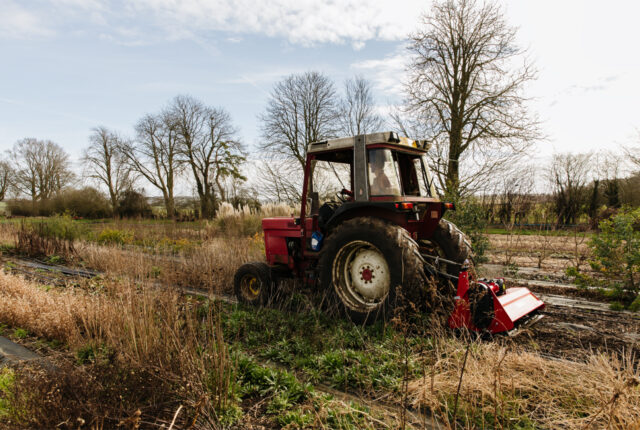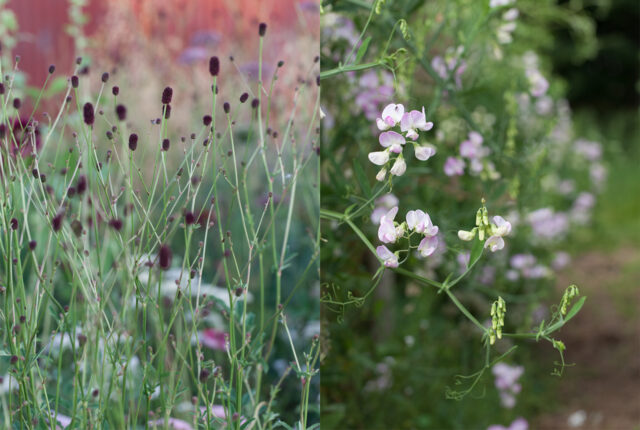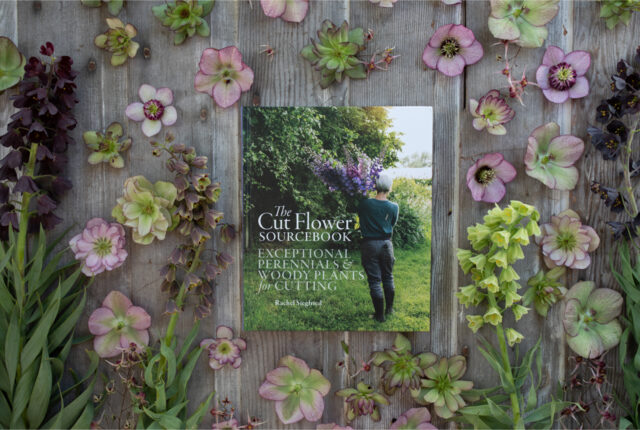Today I’m thrilled to share a special new interview with British flower farmer Rachel Siegfried of Green and Gorgeous. I have been following Rachel’s journey for many years now and it has been so much fun to watch her business grow and evolve over time.
 When we visited England four years ago we got to see Rachel’s beautiful farm, and Chris and I both came away so inspired by what she and her partner Ash have created.
When we visited England four years ago we got to see Rachel’s beautiful farm, and Chris and I both came away so inspired by what she and her partner Ash have created.
I’m excited to welcome Rachel back to the blog (you can read our 2015 interview here), this time to discuss her newest book, all about perennials and shrubs.
 Rachel, I’m so happy to have you back on the blog for a new interview. Can you please tell readers a bit about yourself and your wonderful business?
Rachel, I’m so happy to have you back on the blog for a new interview. Can you please tell readers a bit about yourself and your wonderful business?
Thanks, Erin, I am delighted to be back. The idea of Green and Gorgeous developed in 2002 when I began work in a walled garden on a country estate growing cut flowers for the big house.
Over 6 years I immersed myself in floriculture and how to arrange in a natural style. I was convinced that these garden-grown beauties needed to be shared with a wider public. So when the opportunity came to rent a 2-acre organic market garden I decided to take a leap of faith.
 My aim was to grow everything I needed to create border-to-vase arrangements guided by the seasons and the growth habit of plants. I wanted my flowers to “leave an indelible memory of their fleeting beauty.”
My aim was to grow everything I needed to create border-to-vase arrangements guided by the seasons and the growth habit of plants. I wanted my flowers to “leave an indelible memory of their fleeting beauty.”
Fifteen years on and my garden-led approach is still at the heart of how we grow and sell our flowers. We have grown to 5 acres and now have a team of ten growers and florists producing thousands of stems from March through November for our weddings, shop, and courses.
 When you first started Green and Gorgeous, the slow food movement was on the rise and sustainable floristry was still a novel concept. Can you share a little more about the evolution of the local flower movement in the United Kingdom and where you think it’s headed?
When you first started Green and Gorgeous, the slow food movement was on the rise and sustainable floristry was still a novel concept. Can you share a little more about the evolution of the local flower movement in the United Kingdom and where you think it’s headed?
The shift has been huge. Local, seasonal flowers did not really exist, and the idea of calling myself a flower farmer would not have even occurred to me. We now have hundreds, if not thousands, of growers out there, and many florists are keen to buy British.
Hopefully, the future is bright but with climate change, there are many challenges ahead and I think a shift towards growing the more weather-tolerant plant groups—perennials and woody plants—will be necessary.
 The Cut Flower Sourcebook is one of the most beautiful and practical books I’ve read in such a long time. It’s precisely what gardeners and farmer-florists have been asking for for ages. Can you share what inspired you to write it?
The Cut Flower Sourcebook is one of the most beautiful and practical books I’ve read in such a long time. It’s precisely what gardeners and farmer-florists have been asking for for ages. Can you share what inspired you to write it?
I am so pleased you like the book and I think it has come along at the right time. I had been thinking about writing on this subject since around 2018 when I started to make the switch from predominantly annuals to perennials and woody plants.
 They have always been plant groups that I am very comfortable with because of my background in garden design, in fact, they were the first plants I put in when we were setting up the farm in 2007. I think they translate really well to both the hobbyist cutting from their garden, where perennials and shrubs are a natural fit, and to the flower farmer who might find the only way to scale up labour-wise is to go with low-maintenance plants.
They have always been plant groups that I am very comfortable with because of my background in garden design, in fact, they were the first plants I put in when we were setting up the farm in 2007. I think they translate really well to both the hobbyist cutting from their garden, where perennials and shrubs are a natural fit, and to the flower farmer who might find the only way to scale up labour-wise is to go with low-maintenance plants.
 Writing a book is no small feat. Can you share a little bit about the experience of creating it?
Writing a book is no small feat. Can you share a little bit about the experience of creating it?
As I am sure you know, writing a book is a daunting prospect and initially, I struggled with self-doubt. Thankfully my publisher Anna Mumford of Filbert Press offered a calm and steady hand, guiding me through the process with plenty of positivity and encouragement.
The part I really enjoyed was the photography. I focused on capturing all the plants in the directory whilst Eva Nemeth worked her magic on the arrangements, garden, and working shots.
 In the introduction, you share “Working in a garden every day, particularly a productive one, makes you appreciate that there are actually more than four seasons. The ancient Japanese were onto something when they developed 72 micro seasons, each just five days long.” I love the idea of celebrating these micro seasons. Do you have a favorite?
In the introduction, you share “Working in a garden every day, particularly a productive one, makes you appreciate that there are actually more than four seasons. The ancient Japanese were onto something when they developed 72 micro seasons, each just five days long.” I love the idea of celebrating these micro seasons. Do you have a favorite?
My favourite micro season would have to be April 5 through 9, Tsubame kitaru—Swallows return. We have a pair of swallows that return at this time every spring to nest in our floral studio/shop. It is always a very special moment when they come swooping in.
Their arrival heralds the beginning of the season. All of our flowery hustle and bustle is accompanied by their chatter as they busy themselves with nest-making and raising their young.
 One of the things that stood out to me most while reading The Cut Flower Sourcebook was the images of your arrangements. What do you love the most about arranging flowers and what advice would you give someone who wants to step outside their comfort zone and create something that pushes past what they would normally make?
One of the things that stood out to me most while reading The Cut Flower Sourcebook was the images of your arrangements. What do you love the most about arranging flowers and what advice would you give someone who wants to step outside their comfort zone and create something that pushes past what they would normally make?
I tend not to have any preconceived ideas of what my arrangements will look like. I let the garden take the lead, by choosing a peaceful moment to go for a wander and see what captures my imagination. This is usually first thing in the morning when I am accompanied by birdsong and my whippet Jesse, it feels like quite a meditative process.
 I start by searching for the flower that really inspires me at that moment, which always seems to be something different. I then use this to guide me on what else to pick. I am generally drawn to harmonious colours and contrasting forms and textures.
I start by searching for the flower that really inspires me at that moment, which always seems to be something different. I then use this to guide me on what else to pick. I am generally drawn to harmonious colours and contrasting forms and textures.
 To ensure my designs are well balanced and to give me some parameters, I try to include plant material from the four elements of an arrangement, which I outline in my book—framework, supporting, focal, and the final accent.
To ensure my designs are well balanced and to give me some parameters, I try to include plant material from the four elements of an arrangement, which I outline in my book—framework, supporting, focal, and the final accent.
These building blocks will not only help to create an engaging design but also make it easier to put together.
 The Plant Directory section of your book includes 128 of your favorite bulbs, perennials, climbers, grasses, trees, and shrubs. I think it might just be my favorite part and is something that gardeners all over the world will find incredibly useful. How hard was it to narrow down this section and decide what made the cut?
The Plant Directory section of your book includes 128 of your favorite bulbs, perennials, climbers, grasses, trees, and shrubs. I think it might just be my favorite part and is something that gardeners all over the world will find incredibly useful. How hard was it to narrow down this section and decide what made the cut?
As a plant addict, it was hard to narrow down the plant selection for the directory. It helped to focus on the tried-and-tested varieties we grow here on the farm. It is by no means a comprehensive list on the subject—my intention is to highlight the attributes readers should look for in a plant that makes it a good candidate for cutting.
Everyone will have different growing conditions and floristry styles so hopefully, this directory will act as a springboard to finding their own trusty performers with a relaxed attitude and natural style.
 In addition to growing cut flowers, you also have a specialty seed line, teach workshops, and open your farm to the public. Can you share a little more about these offerings?
In addition to growing cut flowers, you also have a specialty seed line, teach workshops, and open your farm to the public. Can you share a little more about these offerings?
We are open every Saturday from April through October for our farm gate sales.
Our workshops range from growing for business and pleasure to arranging with garden flowers.
I have a couple of new offerings this year which focus on the subject of the book. One is a growing day and the other is about using perennials and woody plants predominantly in arrangements.
 Our seed shop will be reopening in early autumn with fresh stocks and hopefully some new lines that I am trialing this season.
Our seed shop will be reopening in early autumn with fresh stocks and hopefully some new lines that I am trialing this season.
I am working on an online flower farming series with Garden Masterclass, which is being filmed throughout the year.
 Thank you so much, Rachel, for taking the time to share about your beautiful new book with Floret readers. It is such a helpful resource for gardeners all over the world.
Thank you so much, Rachel, for taking the time to share about your beautiful new book with Floret readers. It is such a helpful resource for gardeners all over the world.
 To celebrate the release of Rachel’s new book, The Cut Flower Sourcebook: Exceptional Perennials and Woody Plants for Cutting, we’re giving away five copies. For a chance to win, post a comment below telling us about one of your favorite shrubs or perennials.
To celebrate the release of Rachel’s new book, The Cut Flower Sourcebook: Exceptional Perennials and Woody Plants for Cutting, we’re giving away five copies. For a chance to win, post a comment below telling us about one of your favorite shrubs or perennials.
This giveaway is open to everyone, regardless of where you live, and winners will be announced on June 27.
To learn more about Rachel, be sure to visit her website. You can also follow her on Instagram and Facebook. The Cut Flower Sourcebook is available from Amazon, Barnes & Noble, and Bookshop.org.
Please note: If your comment doesn’t show up right away, sit tight; we have a spam filter that requires us to approve comments before they are published.
Floret only lists companies and products that we love, use, and recommend. All opinions expressed here are our own and Floret does not offer sponsored content or accept money for editorial reviews. If you buy something using the retail links in this post, Floret may receive a small commission. Thank you for your support!






Ashley L. on
I’m super new to the gardening scene (although I have loads of dreams for it!), but one shrub I’ve been eying here in North Texas is Texas Sage. It’s hearty and has a wispy whimsical look to it when the small flowers start blooming, adding just a little pop of color. I’m so inspired by this interview and can’t wait to see the new book!